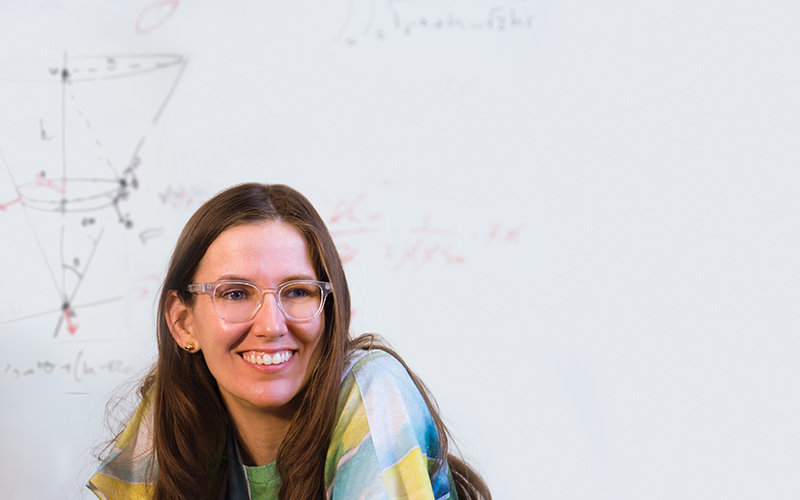
In a galaxy far, far away, about 130 million light years from Earth, a pair of orbiting, massive stars the size of small cities spiraled a dance of death. The neutron stars stretched and distorted the surrounding space-time, giving off energy in the form of powerful gravitational waves. As the dying stars crashed together in a fireball of light, like a spectacular fireworks show in the night sky, heavy elements, such as gold, platinum and lead, sprinkled across the universe.
This cataclysmic smashup of a binary neutron-star system that produced both gravitational waves and light was the discovery astrophysicist Jocelyn Read had been hoping for since setting her sights on studying the stars over a decade ago.
“It was an incredibly rich signal, and we’re only beginning to delve into all the detailed dynamics of this stellar collision,” says Read, whose research helped scientists confirm the gravitational-wave signal was produced from colliding neutron stars.
Read and her colleagues of the international Laser Interferometer Gravitational-Wave Observatory (LIGO) Scientific Collaboration announced in October this never-before-seen event, detected on Aug. 17, 2017, at 8:41 a.m. Eastern Daylight Time. The National Science Foundation-funded Advanced LIGO in Hanford, Washington, and Livingston, Louisiana, made the detection. Working with the Virgo detector near Pisa, Italy, scientists were able to isolate the patch of sky of the atomic collision in the nearby galaxy of NGC 4993. Some 70 observatories on the ground and in space also witnessed the brilliant crash of the exotic dead stars.
At the moment of the colossal star collision, a flash of light — a short gamma-ray burst — was emitted. This observation confirmed a long-held suspicion that neutron-star mergers produce short gamma-ray bursts, a powerful explosion of energy. In the days and weeks that followed, astronomers observed other forms of light across the electromagnetic spectrum, such as X-ray, ultraviolet and radio waves.
“This discovery ushered in a new era in multi-messenger astronomy, sparking coordinated work by astronomers across the globe, and revealing the dynamics of a neutron-star merger,” points out Read, assistant professor of physics and a Cal State Fullerton researcher since 2012.
From this unprecedented observation, scientists solved the mystery of how the universe’s heaviest elements are created, she explains. “Things like our wedding rings and jewelry made of gold and platinum are forged in the mergers of neutron stars.”
The flash of gamma rays produced from the neutron-star collision also confirmed Albert Einstein’s 1915 general theory of relativity, which predicts that light and gravity travel at the same speed.
Unraveling a Mystery
Read served as a lead writer of the journal paper describing the discovery, published in Physical Review Letters. She spent two months analyzing and checking data to ensure accuracy in interpreting LIGO’s gravitational-wave signal.
Her colleagues, physicists Joshua Smith and Geoffrey Lovelace — members of the LIGO Scientific Collaboration — along with undergraduates Erick Leon and Isabella Molina, postdoctoral research associate Marissa Walker, computation specialist Joseph Areeda and physics alumnus Torrey Cullen ’16, a doctoral student at Louisiana State University, were contributors to this latest scientific finding and are co-authors of the discovery paper. Read’s undergraduate students worked with LIGO and Virgo scientists to check and confirm the reliability of the data analysis.
“There is a lot we can learn from the neutron-star merger that we couldn’t learn from binary black-hole mergers,” says Molina. “Neutron stars emit light and this allows us to make observations using telescopes, as well as with the gravitational-wave detectors.”
Read has spent more than a decade studying how neutron stars interact, collide and radiate energy, with the hope that gravitational-wave observations will shed light on the dense matter at the cores of stars. A neutron star, about 12 miles in diameter, is so dense that a teaspoon of neutron-star material has a mass of about a billion tons, Read explains. Through her research, she hopes to better understand the structure and composition of neutron stars and uncover more about the astrophysical history of the universe.
“We are so fortunate to have Jocelyn, one of the world’s neutron-star experts,” notes Smith, associate professor of physics and Dan Black Director of Gravitational-Wave Physics and Astronomy. “I am extremely proud of the role that she and our students have played in this foundational discovery in astronomy.”
Read’s continuing work with LIGO and Virgo includes data analysis to determine the masses, spins, sky location and other properties of this gravitational-wave source. She also is the senior lead of LIGO Scientific Collaboration’s Extreme Matter Group, which coordinates global investigations of neutron-star matter.
The Cal State Fullerton physicists and their students were key contributors to the first direct detection of gravitational waves from merging black holes in 2015. Their research efforts have been instrumental in three more gravitational-wave detections from black holes, including the joint LIGO and Virgo detection on Aug. 14, 2017. For their groundbreaking research in gravitational-wave science, the researchers have been awarded more than $4 million in grants over the last seven years.
While Read is over the moon about this latest observation of the cosmos, she is committed to pushing the frontiers of physics and astronomy.
“There are many more signals and hundreds more scientific implications in our future,” Read promises. “We’re only scratching the surface. There’s a gold mine of science to come.”